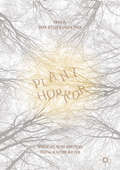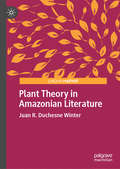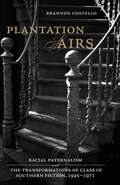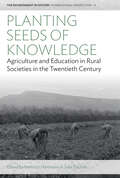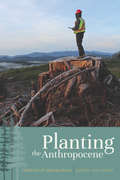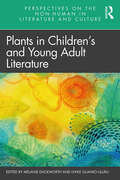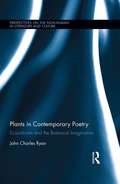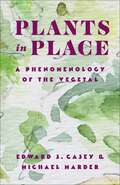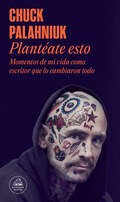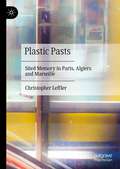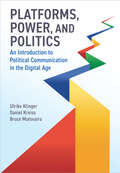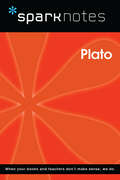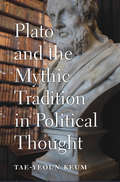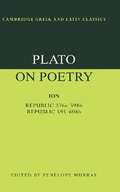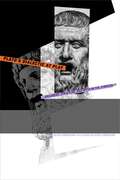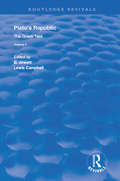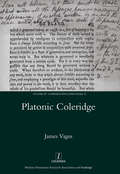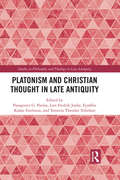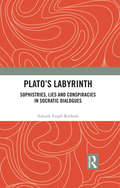- Table View
- List View
Plant Horror
by Dawn Keetley Angela TengaThis collection explores artistic representations of vegetallife that imperil human life, voicing anxieties about our relationship to otherlife forms with which we share the earth. From medieval manuscriptillustrations to modern works of science fiction and horror, plants thatmanifest monstrous agency defy human control, challenge anthropocentricperception, and exact a violent vengeance for our blind and exploitativepractices. Plant Horror explores howdepictions of monster plants reveal concerns about the viability of ourprevailing belief systems and dominant ideologies-- as well as a deep-seatedfear about human vulnerability in an era of deepening ecological crisis. Filmsdiscussed include The Day of the Triffids, Invasion of the Body Snatchers, TheWicker Man, Swamp Thing, and The Happening.
Plant Theory in Amazonian Literature (New Directions in Latino American Cultures)
by Juan R. Duchesne WinterThis book discusses new developments of plant studies and plant theory in the humanities and compares them to the exceptionally robust knowledge about plant life in indigenous traditions practiced to this day in the Amazonian region. Amazonian thinking, in dialogue with the thought of Eduardo Viveiros de Castro, Emanuele Coccia and others, can serve to bring plant theory in the humanities beyond its current focus on how the organic existence of plants is projected into culture. Contemporary Amazonian indigenous literature takes us beyond conventional theory and into the unsuspected reaches of vegetal networks. It shows that what matters about plants are not just their strictly biological and ecological projections, but the manner in which they interact with multiple species and cultural actors in continuously shifting bodies and points of view, by becoming-other, and fashioning a natural and social diplomacy in which humans participate along with non-humans.
Plantation Airs: Racial Paternalism and the Transformations of Class in Southern Fiction, 1945--1971 (Southern Literary Studies)
by Brannon CostelloIn Plantation Airs, Brannon Costello argues persuasively for new attention to the often neglected issue of class in southern literary studies. Focusing on the relationship between racial paternalism and social class in American novels written after World War II, Costello asserts that well into the twentieth century, attitudes and behaviors associated with an idealized version of agrarian antebellum aristocracy -- especially, those of racial paternalism -- were believed to be essential for white southerners. The wealthy employed them to validate their identities as "aristocrats," while less-affluent whites used them to separate themselves from "white trash" in the social hierarchy. Even those who were not legitimate heirs of plantation-owning families found that "putting on airs" associated with the legacy of the plantation could align them with the forces of power and privilege and offer them a measure of authority in the public arena that they might otherwise lack.Fiction by Zora Neale Hurston, Eudora Welty, William Faulkner, Ernest Gaines, Walker Percy, and others reveals, however, that the racial paternalism central to class formation and mobility in the South was unraveling in the years after World War II, when the civil rights movement and the South's increasing industrialization dramatically altered southern life. Costello demonstrates that these writers were keenly aware of the ways in which the changes sweeping the South complicated the deeply embedded structures that governed the relationship between race and class. He further contends that the collapse of racial paternalism as a means of organizing class lies at the heart of their most important works -- including Hurston's Seraph on the Suwanee and her essay "The 'Pet Negro' System," Welty's Delta Wedding and The Ponder Heart, Faulkner's The Mansion and The Reivers, Gaines's Of Love and Dust and his story "Bloodline," and Percy's The Last Gentleman and Love in the Ruins.By examining ways in which these works depict and critique the fall of the plantation ideal and its aftermath, Plantation Airs indicates the richness and complexity of the literary responses to this intersection of race and class. Understanding how many of the modern South's best writers imagined and engaged the various facets of racial paternalism in their fiction, Costello confirms, helps readers construct a more comprehensive picture of the complications and contradictions of class in the South.
Planting Seeds of Knowledge: Agriculture and Education in Rural Societies in the Twentieth Century (Environment in History: International Perspectives #24)
by Julia Tischler Heinrich HartmannIn the late nineteenth and early twentieth centuries, agricultural practices and rural livelihoods were challenged by changes such as commercialization, intensified global trade, and rapid urbanization. Planting Seeds of Knowledge studies the relationship between these agricultural changes and knowledge-making through a transnational lens. Spanning exchanges between different parts of Europe, North and South America, the Indian subcontinent, and Africa, the wide-reaching contributions to this volume reform current historiography to show how local experiences redefined global practice.
Planting the Anthropocene: Rhetorics of Natureculture
by Jennifer Clary-LemonPlanting the Anthropocene is a rhetorical look into the world of industrial tree planting in Canada that engages the themes of nature, culture, and environmental change. Bringing together the work of material ecocriticism and critical affect studies in service of a new materialist environmental rhetoric, Planting the Anthropocene forwards a frame that can be used to work through complex scenes of anthropogenic labor. Using the results of interviews with seasonal Canadian tree planters, Jennifer Clary-Lemon interrogates the complex and messy imbrication of nature-culture through the inadequate terminology used to describe the actual circumstances of the planters’ work and lives—and offers alternative ways to conceptualize them. Although silvicultural workers do engage with the limiting rhetoric of efficiency and humanism, they also make rhetorical choices that break down the nature-culture divide and orient them on a continuum that blurs the boundaries between the given and the constructed, the human and nonhuman. Tree-planting work is approached as a site of a deep-seated materiality—a continued re-creation of the land’s “disturbance”—rather than a simplistic form of doing good that further separates humans from landscapes. Jennifer Clary-Lemon’s view of nature and the Anthropocene through the lens of material rhetorical studies is thoroughly original and will be of great interest to students and scholars of rhetoric and composition, especially those focused on the environment.
Plants in Children’s and Young Adult Literature (Perspectives on the Non-Human in Literature and Culture)
by Melanie DuckworthFrom the forests of the tales of the Brothers Grimm to Enid Blyton’s The Faraway Tree, from the flowers of Cicely May Barker’s fairies to the treehouse in Andy Griffith and Terry Denton’s popular 13-Storey Treehouse series, trees and other plants have been enduring features of stories for children and young adults. Plants act as gateways to other worlds, as liminal spaces, as markers of permanence and change, and as metonyms of childhood and adolescence. This anthology is the first compilation devoted entirely to analysis of the representation of plants in children’s and young adult literatures, reflecting the recent surge of interest in cultural plant studies within the environmental humanities. Mapping out and presenting an internationally inclusive view of plant representation in texts for children and young adults, the volume includes contributions examining European, American, Australian, and Asian literatures and contributes to the research fields of ecocriticism, critical plant studies, and the study of children’s and young adult literatures.
Plants in Contemporary Poetry: Ecocriticism and the Botanical Imagination (Perspectives on the Non-Human in Literature and Culture)
by John RyanPositioned within current ecocritical scholarship, this volume is the first book-length study of the representations of plants in contemporary American, English, and Australian poetry. Through readings of botanically-minded writers including Les Murray, Louise Glück, and Alice Oswald, it addresses the relationship between language and the subjectivity, agency, sentience, consciousness, and intelligence of vegetal life. Scientific, philosophical, and literary frameworks enable the author to develop an interdisciplinary approach to examining the role of plants in poetry. Drawing from recent plant science and contributing to the exciting new field of critical plant studies, the author develops a methodology he calls "botanical criticism" that aims to redress the lack of emphasis on plant life in studies of poetry. As a subset of ecocriticism, botanical criticism investigates how poets engage with plants literally and figuratively, materially and symbolically, in their works. Key themes covered in this volume include plants as invasives and weeds in human settings; as sources of physical and spiritual nourishment; as signifiers of region, home, and identity; as objects of aesthetics and objectivism; and, crucially, as beings with their own perspectives, voices, and modes of dialogue. Ryan demonstrates that poetic imagination is as essential as scientific rationality to elucidating and appreciating the mysteries of plant-being. This book will appeal to a multidisciplinary readership in the fields of ecocriticism, ecopoetry, environmental humanities, and ecocultural studies, and will be of interest to researchers in the emerging area of critical plant studies.
Plants in Place: A Phenomenology of the Vegetal (Critical Life Studies)
by Edward S. Casey Michael MarderPlants are commonly considered immobile, in contrast to humans and other animals. But vegetal existence involves many place-based forms of change: stems growing upward, roots spreading outward, fronds unfurling in response to sunlight, seeds traveling across wide distances, and other intricate relationships with the surrounding world. How do plants as sessile, growing, decaying, and metamorphosing beings shape the places they inhabit, and how are they shaped by them? How do human places interact with those of plants—in lived experience; in landscape painting; in cultivation and contemplation; in forests, fields, gardens, and cities?Examining these questions and many more, Plants in Place is a collaborative study of vegetal phenomenology at the intersection of Edward S. Casey’s phenomenology of place and Michael Marder’s plant-thinking. It focuses on both the microlevel of the dynamic constitution of plant edges or a child’s engagement with moss and the macrolevel of habitats that include the sociality of trees. This compelling portrait of plants and their places provides readers with new ways to appreciate the complexity and vitality of vegetal life. Eloquent, descriptively rich, and insightful, the book also shows how the worlds of plants can enhance our understanding and experience of place more broadly.
Plantéate esto: Momentos de mi vida como escritor que lo cambiaron todo
by Chuck PalahniukEl libro más personal del célebre autor de El club de la lucha: una guía indispensable y original para aspirantes a escritores. Tras más de dos décadas dedicado a la escritura, el aclamado autor de El club de la lucha ha decidido compartir su sabiduría y sus años de experiencia en el arte de contar historias. Palahniuk revela los conocimientos que él mismo ha ido acumulando con los años, gracias a su gran capacidad de observación, a los talleres literarios en los que se formó, y a los escritores y maestros que, como Tom Spanbauer, influyeron en su obra. Palahniuk nos regala una sólida guía práctica para construir y desarrollar una novela (con propuestas únicas que no aparecen en los manuales de escritura), y nos habla de los tipos de personajes que conforman una trama, de la escritura como terapia o de cómo implicar al lector para que empatice con la narración. Las ideas que plantea incluyen desde consejos prácticos y ejemplos de obras clásicas y de sus propios libros, hasta un sinfín de anécdotas y recuerdos de su vida como escritor y de sus años de tours literarios por el mundo. Esta obra, destinada a convertirse en un referente de los libros sobre la escritura, es una lúcida, sensible y experta carta de amor al oficio de escritor. La crítica ha dicho:«Con reminiscencias a Mientras escribo de Stephen King, que es tan entretenido como didáctico, [Plantéate esto] es un recurso indispensable para escritoresPublishers Weekly «Palahniuk revela una humildad sorprendente con ideas frescas y accesibles. Sus fans apreciarán el análisis de su propio trabajo —especialmente con El club de la lucha (1996)—, sus homenajes a amigos y antecesores, y cómo imparte sabiduría de una forma amable y alentadora en su particular tono coloquial».Booklist «Un maestro cargado de sabiduría. [Palahniuk] ofrece consejos muy detallados y sumamente prácticos».Kirkus Reviews «Un libro esclarecedor».Dallas Morning News «Consejos prácticos y veraces para aspirantes a escritores».USA Today «Una de las imaginaciones más febriles de las letras estadounidenses».The Washington Post «Palahniuk no escribe para turistas. Escribe para devotos incondicionales que se sienten atraídos por la imaginación salvaje y furiosa que desprende, y por ese sobresaliente humor con el que rompe tabúes».Janet Maslin, The New York Times
Plastic Pasts: Sited Memory in Paris, Algiers and Marseille
by Christopher LefflerThis book uses plasticity as a metaphor for understanding how the past endures and evolves within the landscape, and the ways in which remembering shapes the sites we occupy and use. The plastic site is characterised both by its resilience, its form never entirely altered from an earlier mould, and by its malleability, which ensures that whatever persists is inevitably transformed. Embodied in its present configuration are the many moments that have produced it over time, and these are continually supplemented and modified. Surveying examples from Paris, Algiers and Marseille, and media as diverse as literature, film, photography, blogs and video games, Plastic Pasts interrogates how different communities and cultural producers have grappled with the present past in space as an enduring and dynamic memory. It argues that understanding sited memory as plastic entails recognising a multiplicity of immutable pasts that exist in a permanent state of ongoing evolution.
Platforms, Power, and Politics: An Introduction to Political Communication in the Digital Age
by Bruce Mutsvairo Daniel Kreiss Ulrike KlingerPolitical communication has fundamentally transformed as digital technologies have become increasingly important in everyday life. Technology platforms have become powerful political instruments for world leaders, campaigns, social movements, journalists, and non-governmental organizations. Moreover, they are essential to how people communicate about politics, encounter and share political information, and take action to pursue their political goals. This is the first textbook to center digital platforms in understanding political communication. With global examples beyond the context of Western democracies, the text reveals how digital technologies such as social media and search engines are increasingly shaping political communication in countries around the world. It shows how the core processes of political communication are being reshaped by platforms, from how elections are contested to how issues make it onto policymaking agendas. Topics covered include public opinion, journalism, strategic communication, political parties, social movements, governance, disinformation, propaganda, populism, race, ethnicity, and democratic backsliding. Full of lively examples and pedagogical features, Platforms, Power, and Politics offers an exciting and innovative new approach to political communication. It is essential reading for students of political communication and an important resource for scholars, journalists, and policymakers.
Plato (SparkNotes Philosophy Guide)
by SparkNotesPlato (SparkNotes Philosophy Guide) Making the reading experience fun! SparkNotes Philosophy Guides are one-stop guides to the great works of philosophy–masterpieces that stand at the foundations of Western thought. Inside each Philosophy Guide you&’ll find insightful overviews of great philosophical works of the Western world.
Plato and the Divided Self
by Tad Brennan Charles Brittain Rachel BarneyPlato's account of the tripartite soul is a memorable feature of dialogues like the Republic, Phaedrus and Timaeus: it is one of his most famous and influential yet least understood theories. It presents human nature as both essentially multiple and diverse - and yet somehow also one - divided into a fully human 'rational' part, a lion-like 'spirited part' and an 'appetitive' part likened to a many-headed beast. How these parts interact, how exactly each shapes our agency and how they are affected by phenomena like eros and education is complicated and controversial. The essays in this book investigate how the theory evolves over the whole of Plato's work, including the Republic, Phaedrus and Timaeus, and how it was developed further by important Platonists such as Galen, Plutarch and Plotinus. They will be of interest to a wide audience in philosophy and classics.
Plato and the Invention of Life
by Michael NaasThe question of life, Michael Naas argues, though rarely foregrounded by Plato, runs through and structures his thought. By characterizing being in terms of life, Plato in many of his later dialogues, including the Statesman, begins to discover—or, better, to invent—a notion of true or real life that would be opposed to all merely biological or animal life, a form of life that would be more valuable than everything we call life and every life that can actually be lived.This emphasis on life in the Platonic dialogues illuminates the structural relationship between many of Plato’s most time-honored distinctions, such as being and becoming, soul and body. At the same time, it helps to explain the enormous power and authority that Plato’s thought has exercised, for good or ill, over our entire philosophical and religious tradition.Lucid yet sophisticated, Naas’s account offers a fundamental rereading of what the concept of life entails, one that inflects a range of contemporary conversations, from biopolitics, to the new materialisms, to the place of the human within the living world.
Plato and the Mythic Tradition in Political Thought
by Tae-Yeoun KeumAn ambitious reinterpretation and defense of Plato’s basic enterprise and influence, arguing that the power of his myths was central to the founding of philosophical rationalism.Plato’s use of myths—the Myth of Metals, the Myth of Er—sits uneasily with his canonical reputation as the inventor of rational philosophy. Since the Enlightenment, interpreters like Hegel have sought to resolve this tension by treating Plato’s myths as mere regrettable embellishments, irrelevant to his main enterprise. Others, such as Karl Popper, have railed against the deceptive power of myth, concluding that a tradition built on Platonic foundations can be neither rational nor desirable.Tae-Yeoun Keum challenges the premise underlying both of these positions. She argues that myth is neither irrelevant nor inimical to the ideal of rational progress. She tracks the influence of Plato’s dialogues through the early modern period and on to the twentieth century, showing how pivotal figures in the history of political thought—More, Bacon, Leibniz, the German Idealists, Cassirer, and others—have been inspired by Plato’s mythmaking. She finds that Plato’s followers perennially raised the possibility that there is a vital role for myth in rational political thinking.
Plato and the Traditions of Ancient Literature
by Richard HunterExploring both how Plato engaged with existing literary forms and how later literature then created 'classics' out of some of Plato's richest works, this book includes chapters on such subjects as rewritings of the Apology and re-imaginings of Socrates' defence, Plato's high style and the criticisms it attracted, and how Petronius and Apuleius threaded Plato into their wonderfully comic texts. The scene for these case studies is set through a thorough examination of how the tradition constructed the relationship between Plato and Homer, of how Plato adapted poetic forms of imagery to his philosophical project in the Republic, of shared techniques of representation between poet and philosopher and of foreshadowings of later modes of criticism in his Ion. This is a major contribution to Platonic studies, to the history of Platonic reception from the fourth century BC to the third century AD and to the literature of the Second Sophistic.
Plato on Poetry: Ion; Republic 376e-398b9; Republic 595-608b10 (Cambridge Greek and Latin Classics)
by Penelope MurrayPrior to publication of this 1996 book, much had been written on Plato as a critic of literature, but no commentaries had appeared in English on the Ion, or the opening books of the Republic in which Plato launches his famous attack on poetry, since the early years of this century. This volume brings together these texts and the relevant section of Republic 10. It aims to provide the reader with a commentary which takes account of modern scholarship on the subject, and which explores the ambivalence of Plato's pronouncements on poetry through an analysis of his own skill as a writer. A general introduction sets Plato's views in the wider context of attitudes to poetry in Greek society before his time, and indicates the main ways in which his writings on poetry have influenced the history of aesthetic thought in European culture.
Plato on the Value of Philosophy
by Tushar IraniPlato was the first philosopher in the western tradition to reflect systematically (and often critically) on rhetoric. In this book, Tushar Irani presents a comprehensive and innovative reading of the Gorgias and the Phaedrus, the only two Platonic dialogues to focus on what an 'art of argument' should look like, treating each of the texts individually, yet ultimately demonstrating how each can best be understood in light of the other. For Plato, the way in which we approach argument typically reveals something about our deeper desires and motivations, particularly with respect to other people, and so the key to understanding his views on the proper practice of argument lies in his understanding of human psychology. According to this reading, rhetoric done well is simply the practice of philosophy, the pursuit of which has far-reaching implications for how we should relate to others and how we ought to live.
Plato's Dialectic at Play: Argument, Structure, and Myth in the Symposium
by Kevin Corrigan Elena Glazov-CorriganThe Symposium is one of Plato’s most accessible dialogues, an engrossing historical document as well as an entertaining literary masterpiece. By uncovering the structural design of the dialogue, Plato’s Dialectic at Play aims at revealing a Plato for whom the dialogical form was not merely ornamentation or philosophical methodology but the essence of philosophical exploration. His dialectic is not only argument; it is also play. Careful analysis of each layer of the text leads cumulatively to a picture of the dialogue’s underlying structure, related to both argument and myth, and shows that a dynamic link exists between Diotima’s higher mysteries and the organization of the dialogue as a whole. On this basis the authors argue that the Symposium, with its positive theory of art contained in the ascent to the Beautiful, may be viewed as a companion piece to the Republic, with its negative critique of the role of art in the context of the Good. Following Nietzsche’s suggestion and applying criteria developed by Mikhail Bakhtin, they further argue for seeing the Symposium as the first novel. The book concludes with a comprehensive reevaluation of the significance of the Symposium and its place in Plato’s thought generally, touching on major issues in Platonic scholarship: the nature of art, the body-soul connection, the problem of identity, the relationship between mythos and logos, Platonic love, and the question of authorial writing and the vanishing signature of the absent Plato himself.
Plato's Dialectic at Play: Argument, Structure, and Myth in the Symposium
by Kevin Corrigan Elena Glazov-CorriganThe Symposium is one of Plato’s most accessible dialogues, an engrossing historical document as well as an entertaining literary masterpiece. By uncovering the structural design of the dialogue, Plato’s Dialectic at Play aims at revealing a Plato for whom the dialogical form was not merely ornamentation or philosophical methodology but the essence of philosophical exploration. His dialectic is not only argument; it is also play. Careful analysis of each layer of the text leads cumulatively to a picture of the dialogue’s underlying structure, related to both argument and myth, and shows that a dynamic link exists between Diotima’s higher mysteries and the organization of the dialogue as a whole. On this basis the authors argue that the Symposium, with its positive theory of art contained in the ascent to the Beautiful, may be viewed as a companion piece to the Republic, with its negative critique of the role of art in the context of the Good. Following Nietzsche’s suggestion and applying criteria developed by Mikhail Bakhtin, they further argue for seeing the Symposium as the first novel. The book concludes with a comprehensive reevaluation of the significance of the Symposium and its place in Plato’s thought generally, touching on major issues in Platonic scholarship: the nature of art, the body-soul connection, the problem of identity, the relationship between mythos and logos, Platonic love, and the question of authorial writing and the vanishing signature of the absent Plato himself.
Plato's Republic: The Greek Text (Routledge Revivals)
by B. JOWETT AND LEWIS CAMPBELLFirst published in 1894, this book consists of essays by professors Jowett and Campbell about the classic Greek philosopher Plato, and his famous and widely read dialogue The Republic, which is considered one the world’s most influential works. Plato is believed to be the pivotal figure in the development of Western philosophy, and the editors explore this throughout the book along with relations to other Greek dialogues and authors.
Platonic Coleridge
by James Vigus"The ambivalent curiosity of the young poet Samuel Taylor Coleridge (1772-1834) towards Plato - 'but I love Plato - his dear gorgeous nonsense!' - soon developed into a philosophical project, and the mature Coleridge proclaimed himself a reviver of Plato's unwritten or esoteric 'systems'. James Vigus's study traces Coleridge's discovery of a Plato marginalised in the universities, and examines his use of German sources on the 'divine philosopher', and his Platonic interpretation of Kant's epistemology. It compares Coleridge's figurations of poetic inspiration with models in the Platonic dialogues, and investigates whether Coleridge's esoteric 'system' of philosophy ultimately fulfilled the Republic's notorious banishment of poetry."
Platonism and Christian Thought in Late Antiquity (Studies in Philosophy and Theology in Late Antiquity)
by Panagiotis G. Pavlos Lars Fredrik Janby Eyjólfur Kjalar Emilsson Torstein Theodor TollefsenPlatonism and Christian Thought in Late Antiquity examines the various ways in which Christian intellectuals engaged with Platonism both as a pagan competitor and as a source of philosophical material useful to the Christian faith. The chapters are united in their goal to explore transformations that took place in the reception and interaction process between Platonism and Christianity in this period. The contributions in this volume explore the reception of Platonic material in Christian thought, showing that the transmission of cultural content is always mediated, and ought to be studied as a transformative process by way of selection and interpretation. Some chapters also deal with various aspects of the wider discussion on how Platonic, and Hellenic, philosophy and early Christian thought related to each other, examining the differences and common ground between these traditions. Platonism and Christian Thought in Late Antiquity offers an insightful and broad ranging study on the subject, which will be of interest to students of both philosophy and theology in the Late Antique period, as well as anyone working on the reception and history of Platonic thought, and the development of Christian thought.
Plato’s Labyrinth: Sophistries, Lies and Conspiracies in Socratic Dialogues
by Aakash Singh RathoreThis original and stimulating study of Plato's Socratic dialogues rereads and reinterprets Plato's writings in terms of their dialogical or dramatic form. Taking inspiration from the techniques of Umberto Eco, Jacques Derrida, and Leo Strauss, Aakash Singh Rathore presents the Socratic dialogues as labyrinthine texts replete with sophistries and lies that mask behind them important philosophical and political conspiracies. Plato's Labyrinth argues that these conspiracies and intrigues are of manifold kinds – in some, Plato is masterminding the conspiracy; in others, Socrates, or the Sophists, are the victims of the conspiracies. With supplementary forays ('intermissions') into the world of Xenophon and the Sophists, the complex and evolving series of overlapping arguments that the book lays out unfold within an edgy and dramatic narrative. Presenting innovative readings of major texts – Plato's Parmenides, Republic, Symposium and Meno as also Homer's Odyssey – this work is an ambitious attempt to synthesize philological, political, historical and philosophical research into a classical text-centred study that is at once of urgent contemporary relevance. This book aims to revitalize the study of ancient Greek thought in all its diverse disciplinary richness and will interest students and scholars across the social sciences and humanities, especially those in philosophy, Greek and classical studies, language and literature, politics, media and culture studies, theatre and performance studies, and history.
Platypus and Fly: Targeting l Blends (Speech Bubbles 2)
by Melissa PalmerFly is sneaky and very cheeky. He likes to tease and annoy other creatures around him. Then he meets Platypus, who is ready for lunch. The race is on, but who will win? This picture book targets /l/ blends and is part of Speech Bubbles 2, a series of picture books that target specific speech sounds within the story. The series can be used for children receiving speech therapy, for children who have a speech sound delay/disorder, or simply as an activity for children’s speech sound development and/or phonological awareness. They are ideal for use by parents, teachers or caregivers. Bright pictures and a fun story create an engaging activity perfect for sound awareness. Picture books are sold individually, or in a pack. There are currently two packs available – Speech Bubbles 1 and Speech Bubbles 2. Please see further titles in the series for stories targeting other speech sounds.
